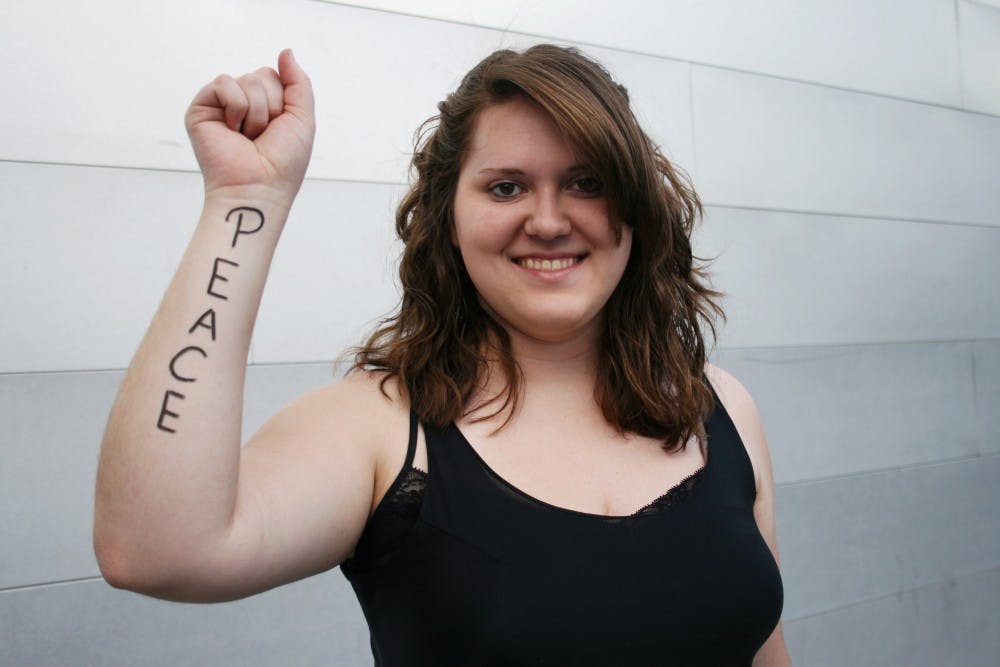 Feeling not beautiful is a struggle many face, and adding to the frustrations is the onslaught of images provided by the media that create the perfect cherry on top.
Feeling not beautiful is a struggle many face, and adding to the frustrations is the onslaught of images provided by the media that create the perfect cherry on top.Photo by Perla Farias
Beauty.
Whether you wear a zero or a 28, I bet your stomach just rolled at the sight of that word. It’s one that gets my heart going every single time as the questions start their inevitable parade through my brain.
Is my hair too frizzy?
Is that hideous zit still on my chin?
Does my stomach look flat enough?
Do I look “normal” today?
Ever since I can remember being coherently aware of my body, I have been frustrated with it.
I developed well ahead of all the girls in my elementary class. I realized I wasn’t the normal 10-year-old who could run and jump and play without a worry in the world. I became self-conscious of my every move.
Fifth grade was the first year I began sucking in my gut, and I haven’t stopped since.
I don’t think there was ever a time I walked out of my room without my abdominal muscles clenched as tightly as possible to achieve a slimming effect.
I spent most nights of my adolescence in the bathroom poking, prodding and pulling at my fat so hard I left bruises and stretch marks.
Then I would spend the rest of the night with a tear-soaked face and a pillow on top of my stomach — because as long as the pillow was there, no one could see that disgusting bit of me.
Why couldn’t I just be beautiful?
There is a song I heard recently by Kimya Dawson called “I Like Giants.” A phrase from the song says, “Cause all girls feel too big sometimes/ Regardless of their size.”
And it could not be more true.
The beauty industry mecca does not help.
It’s no secret that we constantly measure our bodies against the ceaseless onslaught of advertisements, magazines and fashion companies all pandering our current definition of beauty: skinny, toned, tanned and happy.
The media has always played a huge role in projecting a specific, aesthetic ideal of body image to the public. And we have depended on it like outcasts gaping at the popular girls who all look like Regina George and seem to have perfect lives.
 When we go searching for beauty we come across what simply seems unattainable.
When we go searching for beauty we come across what simply seems unattainable.Photo by Perla Farias
We stand in front of the mirror turning this way and that way. With a scrupulous and unforgiving eye, we pull at our extra skin with nails of loathing.
We silently run our fingers over our “problem spots,” desperately wishing they would conform to “perfection” on their own. We think seriously about manually hacking off those extra pounds or gorging ourselves on junk food to get an extra bit of curve or bulk.
Creative writing sophomore Alanna Carranza has dealt extensively with issues of body image and coming to terms with her natural curves.
“For me, I feel like society doesn’t want me here, like if you’re fat, it’s not okay to be here,” she says.
Carranza finds there is discrimination in clothing stores and the sizes sold: “In plus-size stores, sizes only go up to 28. So anything above that is like they just take you out of the equation, like you’re not supposed to exist.”
Carranza says one of the hardest parts of living as an overweight woman has been struggling with dating.
“It’s like men have been taught that liking any other women who aren’t skinny is taboo, like it’s a kink,” she says. “It’s like you’re a person they don’t even regard as female anymore. You’re really stripped of your femininity.”
Lisa Whitaker, a sociology lecturer in the T. Denny Sanford School of Social and Family Dynamics, went through a particularly terrible time during her adolescent years when she had severe acne and thick glasses.
“I had pimple on top of pimple. I had no clear space,” she says. “I was horrible-looking.”
Whitaker says peers and strangers called her a monster, and children would turn away from her in horror.
All of these social norms and thoughts evolve into mania. And this intervention-worthy fanaticism causes us to slip into some mentally unhealthy practices that often drop us to rock bottom.
Cultivating Obsession
While people are constantly exposed to campaigns for better bodies, this fixation on the way we look is triggered long before we notice the diet ads on TV.
“You can’t just say it’s the media, although I think that plays a huge part in fanning the flames,” Whitaker says.
Whitaker says we develop many of our thoughts on body image through our family. Through watching older siblings and listening to parents’ expectations, people create an image of “perfection” that they continually work to obtain.
Whitaker also says we respond to ideas of body image projected from our peer groups at school and from images we absorb from the Internet.
But even with these different avenues of exposure, advertising aimed at physical appearance remains the most omnipotent.
“I would say probably 85 percent of what people struggle with definitely comes from the media,” says Amy Christman, the president of Well Devils Council.
Well Devils Council is a volunteer-based club that aims to establish health and wellness as a fundamental aspect of the ASU lifestyle. WDC works on all four ASU campuses to promote healthy living for all students.
Christman says there are several media outlets that are meant to advocate a fit lifestyle, but they use advertising and diction that confuse people’s understanding of health and appearance.
“Even in magazines where they want to promote health and wellness, you still see ads for diet pills and fat-burners,” Christman says. “And a lot of those buzz words like ‘skinny’ and ‘thin,’ people associate with health and that’s not true. The media definitely skews that.”
Carranza agrees that there is a misconception of heavier people being ignorant of health and not taking care of themselves.
“We’re all very afraid we’re going to be unhealthy, and we’re also afraid of other people being unhealthy and how that’s going to affect us,” she says. “It’s not so much what it looks like, but what it means to be fat.”
Whitaker says the fact that people constantly surround us enables us to break down our personal image.
“People, being social creatures, we have a desire to fit in, to be accepted,” she says. “And so in order to be accepted, we try to make ourselves approximate the in-look.”
And so the “in-look” becomes what we see in beauty media.
“In advertising, a lot of those models aren’t true human beings,” Whitaker says. “They are composites of so-called perfect qualities that have been pasted together.”
According to a study done by beautyredefined.net, the majority of photos that run in magazines and beauty advertisements have been retouched with software like Photoshop. Striking before-and-after images of models and celebrities from their photo shoots have surfaced across the Internet that make us question the value of what we see. Demi Lovato’s figure was completely slimmed and lifted in her cover photo for Cosmo magazine; the same thing happened in Kelly Clarkson’s photo for Self magazine’s September 2009 issue.
This shock has inspired many to protest, but has initiated little change in the industry.
In early July of 2012, a 14-year-old reader of Seventeen magazine started a petition asking the editors to run one unaltered spread each month. However, in response to the petition, editor-in-chief Ann Shoket replied that they would continue their policy of not altering “face or body shapes.”
Therefore, they are still altered in terms of removing things like flyaway hairs and bra straps, as well as affecting colors to create a more aesthetic picture.
Behind the Image
The pressure goes both ways: toward the viewer and toward the model.
There are extreme expectations placed on models to conform to the media’s accepted ideal of normalcy.
Nineteen-year-old Lucas Machado left the university to pursue a career in modeling with Arizona Model Management. The former ASU student says he has experienced the competitive nature of the modeling industry first-hand.
“Your measurements in height, weight and clothing sizes have to be spot on to be signed with a major agency,” he says in an online correspondence. “Your agency is always pushing you to stay in shape and go to the gym to stay healthy and to land those big jobs.”
Machado says he thinks the media focuses on men that “are very muscular, in shape and generally good-looking.” Men also struggle with the media-fabricated image of masculinity that is impossible to gain, which can also lead to unhealthy practices.
According to an article from British news website independent.co.uk, many modeling agencies are seeking skinnier men to showcase their clothes.
“They say designers no longer want a buffed, toned male body to show off their clothes. Instead, they want waifs who can rival women in slenderness and androgynous looks,” the article states. The story goes on to tell the story of model Ron Saxen who battled anorexia and dropped 205 pounds in order to secure a modeling contract.
Machado says major changes are needed in both the media and the modeling industry.
“People look at the media and most want to look like the people that are exposed in it,” he says. “If a client puts a girl that is 90 pounds on the runway, there are many girls who will do whatever it takes to look like that.”
And to think that around 60 years ago, advertisers were encouraging the public to gain weight.
You read that right — beauty advertisers were encouraging people to expand our waistlines.
Vintage advertisements of voluptuous, women and beefed-up men encourage the purchase of weight-gain products with phrases like “Don’t let them call you skinny,” “Skinny girls are not glamour girls,” and “A skinny man hasn’t a chance.”
The optimal image has since made a complete 180-degree change within the beauty business, yet we are no closer to embracing human naturalism — and people are hurting.
Dying to be Perfect
According to studies from the National Eating Disorders Association, “In the United States, 20 million women and 10 million men suffer from a clinically significant eating disorder at some time in their life.”
These studies also show that in 2011, 40-60 percent of girls ages 6-12 were concerned with their weight and shape.
 Seeing images that define beauty leads many to go to lengths to appear, feel and be accepted as beautiful.
Seeing images that define beauty leads many to go to lengths to appear, feel and be accepted as beautiful.Photo by Perla Farias
“They [the media] are almost like a mirror we look into,” Whitaker says. “If the reflection we are getting back is very different than what we know we look like, we are dissatisfied and we want to change it.”
I remember looking into that mirror. The glossy, printed pages started to feel like sandpaper with every turn.
Spending years in a mental valley of self-loathing, I developed an aversion toward food. Every morsel I ate became an instant regret, and for a year, I skipped lunch at school and sometimes went without dinner.
This horrible, double-sided feeling of a gaping, empty stomach along with the way my jeans resisted my waist made every bite an emotional catastrophe.
For me, it wasn’t really a conscious devotion to anorexia — I just didn’t want to have that weight of regret on my shoulders any longer than I needed to.
But I didn’t want to die, either.
A study done by the South Carolina Department of Mental Health showed that 20 percent of those suffering from anorexia die prematurely from complications of their eating disorder.
We are facing an epidemic of self-loathing and hopelessness from truly beautiful people who are literally dying to please society’s media-driven image of perfection.
However, as hard it is to accept, true beauty lies in embracing our natural merits.
Making Peace
Because we have been conditioned to think certain ways about our bodies, accepting and embracing our bodies in their natural design is one of the most difficult things to do.
“If you stop and look, you’ll realize that you’re hearing these things from people you don’t know and who don’t know you,” Carranza says of seeing body image through the media. “And they’re telling you to do something with your body all the time, which is not right.”
Finding a community of like-minded and like-experienced people can set the wheels of change in motion.
When Carranza joined Tumblr, she was introduced to a virtual world of women like her who were proud of their bodies and helped her come to terms with her own beauty.
“Seeing other people being strong and questioning what was going on helped me question why I look at myself and other women the way I do,” she says.
Through this community, Carranza has been able to embrace her body and focus on her health rather than her image.
“For me, I believe that my body wants to be big, and I don’t see anything wrong with that,” she says. “I really have to fight for my right to be female and wear what I want to wear.”
When dealing with body image, negativity resonates so loudly that it drowns any chance of positivity.
One day, someone complimented my smile. I, self-consciously, brushed it off as some sort of mistake.
But then someone else told me they wished that they could have naturally curly hair like mine. And another someone said they would kill for my hourglass figure.
Slowly, I started to give the sweet harmonies of compliments as much resonance as I gave the pounding drums of negativity. After a while, I was able to look in the mirror and say to myself, “You are so beautiful.”
And I cried.
 Body Peace is about finding the subtle details that make us as individual all that more worthwhile.
Body Peace is about finding the subtle details that make us as individual all that more worthwhile.Photo by Perla Farias
I cried when I realized that somehow, I had worked my way out of that valley of depression and I could get excited about clothes and eat delicious things and truly enjoy them.
It took me years to get to where I am in accepting my body, and I am still working. I didn’t know that there were other women who did and felt the same things as me, and I didn’t know how to go about changing things.
Carranza says the way to start is to cut to the core and find out what makes you think the way you do about your body and how you view others.
“If something or someone doesn’t make you feel good about yourself and your body, you need to remove them and create a space for yourself where you’re okay with your body,” she says.
President of Downtown Phoenix Campus Aware, Dean Thap, agrees that people should keep a positive atmosphere around them when dealing with these issues.
Aware is a club dedicated to raising preventative awareness and education about common wellness issues among ASU students, including cultivating a healthy body image.
“I would tell students to know what kind of body type they have and learn about what they can do to maintain a healthy body image for that type,” Thap says. “We have to keep in mind that we are all different and we can only do so much to look like someone else.”
And even when we get what we want, it can be hard to re-enter society in the same frame of mind.
When Whitaker’s parents had some extra money, they used it to clear up her skin and buy her contacts.
“I went from the ugly duckling to the beautiful swan and suddenly I had men falling over themselves to go out with me,” she says. “What a lesson about the degree to which our culture prioritizes appearance.”
Whitaker says it was hard for her to accept compliments after that experience, because they were always superficially driven. At that moment, she made a commitment to focus on what was inside rather than the appearance of men she chose to date.
“It was a really hard way to learn that lesson, but boy, did I learn,” she says. “It’s a lesson I wish everybody could learn without going through something unpleasant.”
We all have this similar idea in our heads: if we become thin with clear skin and perfect hair, all our dreams will come true. We will be accepted and welcomed into a society that equates happiness and appearance.
But that’s wrong.
The natural curves and contours of our bodies are what make us inherently human. Instead of struggling to find clothing that expresses our individuality, we should embrace the unique bodies we have already been given.
Instead of chastising our bodies we should be celebrating them.
And what if we did?
What if the beauty industry started using models and images of more natural people?
“I think they would sell more clothes if they manufactured clothes that are realistic for real humans to wear,” Whitaker says. “Most women do have hips and that should be celebrated.”
Carranza says she thinks people would be put off by that movement toward reality, but says she would feel more comfortable looking at a spectrum of body types rather than one ideal.
“At first I think people would be confused, but I think that would be a really healthy way for them to go,” she says. “Seeing women who are closer to your size would be healthy for women, and especially young girls, to see.”
There is one phrase of Dawson’s song that resonated with me while writing this: “We all become important when we realize our goal / Should be to figure out our role within the context of the whole.”
We need to not only glorify our natural figures, but also value our ideas more than the mirror.
Putting these things together will help us see ourselves as absolutely and beautifully human.
Even though at times I’m overwhelmed and berated by the negative in the morning, I’ve been able to silence it more quickly.
I do have those days where nothing feels right about my body. But now, instead of letting the book of my flaws rule my mood for the day, I’ve focused on the chapters that list my naturally beautiful attributes; and that leads to about ten minutes gazing in the mirror admiring my legs or my eyes or my hair for that day.
I am nowhere near complete body peace. But once I realized I was unhappy, I was able to compliment myself each day and finally feel at ease when I walked out the door. Today, I spent ten minutes admiring my legs in my knock-off, full-length mirror, but tomorrow morning I will think about that bouncing curl that falls just by my cheek.
And it will make me smile as I re-enter the world armed with both insecurities and an optimistic outlook.
Reach the writer at mamccrea@asu.edu or via Twitter @MackenzieMicro




